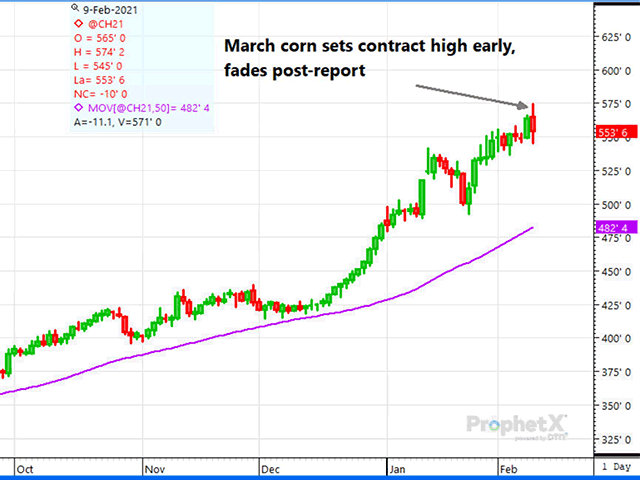USDA Reports Review
WASDE Sees Corn Stocks Decline; Beans Rally on Tightening Supplies
The February World Agricultural Supply and Demand Estimates (WASDE) report surprised traders with a lower-than-expected increase in U.S. corn sales. U.S. soybean and wheat stocks came in about as expected, with ending soy stocks of just 120 million bushels (mb), the lowest since 2013-14.
Below is an in-depth look at some of the changes in both U.S. and world numbers from the Feb. 9 report.
CORN
Prior to the release of the report, March corn futures had carved out another new contract high of $5.74 1/4. While Dow Jones' pre-report estimate looked for an increase of nearly 160 mb in U.S. corn exports, USDA instead chose to raise exports just 50 mb. The result was a 1.502 billion-bushel (bb) ending stocks number, which sent the corn market reeling. With the current torrid export pace for U.S. corn and with the 6.5 million-metric-ton (256 mb) rise in China corn imports to 24 mmt (945 mb), this minor change made little sense to traders and encouraged long liquidation.
On the world front, the average pre-report estimate had ending stocks falling to 280 mmt, a decline of 3.8 mmt from January. Instead, world ending stocks were pegged at 286.5 mmt (11.28 bb), a gain of 2.7 mmt and adding another bearish segment to the report.
China imports were increased by 6.5 mmt to 24 mmt, while China feed demand increased by 6 mmt to 206 mmt (8.1 bb) and China's ending stocks increased by 4.5 mmt to 196.18 mmt (7.7 bb). EU imports fell by 2.5 mmt, while Japan and South Korean corn imports also fell by nearly 500,000 metric tons (mt) each.
P[L1] D[0x0] M[300x250] OOP[F] ADUNIT[] T[]
USDA didn't change corn production for Argentina or Brazil, leaving them at 109 mmt (4.29 bb) and 47.5 mmt (1.87 bb), respectively. This was a surprise to many traders, who had looked for a modest decline in each due to the dry weather in both southern Brazil and Argentina.
SOYBEANS
As expected, the report featured a modest increase in U.S. soybean sales of 20 mb to 2.25 bb, sending U.S. ending stocks to the tightest level in seven years, at 120 mb. That is down from 523 mb in 2019-20. The decline was about as expected, with many traders now assuming that soybeans will need to rise to discourage further demand. There was no increase in either crush or imports, which some in the trade feel will be necessary at some point.
On the world level, traders had expected just a minor downward revision in global ending stocks, and that's what they got. Ending stocks fell by nearly 1 mmt to 83.36 mmt (3.06 bb). There were few notable changes, with China soy imports left unchanged at 100 mmt, but Argentine imports raised by 500,000 mt. As was the case in corn, USDA chose to leave both Argentine and Brazilian production unchanged at 48 mmt (1.76 bb) and 133 mmt (4.89 bb), respectively. The average trade estimate had looked for a modest decline in both.
WHEAT
Little change was expected on the domestic front, and while U.S. ending stocks came out at unchanged from January at 836 mb, there were some notable by-class revisions that bear mentioning. With U.S. hard red winter (HRW) wheat exports running behind the estimated pace, exports were lowered, leading to a 28 mb higher ending stocks number of 362 mb. On the other hand, both hard red spring (HRS) wheat and white wheat are running ahead of the projected export pace, and ending stocks of each were lowered. HRS wheat stocks fell by 21 mb and white wheat by 10 mb.
On the world front, global wheat production rose to a record-large 773.4 mmt (28.4 bb), and consumption was up by 9.8 mmt to 769.3 mmt (28.2 bb). Notable changes were China's wheat imports rising by 1 mmt to 10 mmt, China's feed usage rising by 4 mmt to 30 mmt and China's total usage rising by 5 mmt to a record-large 140 mmt (5.1 bb). India's usage rose by 3.5 mmt. The net effect of the world wheat changes was to drop global ending stocks by a greater-than-expected 9 mmt to 304.2 mmt (11.2 bb). The trade had anticipated ending stocks to be 8.4 mmt higher than that at 312.6 mmt.
CONCLUSION
While the February 2021 WASDE reinforced the ongoing trend of tighter U.S. and world supplies, the corn numbers were disappointing to bulls, including the very long funds. The minor increase in U.S. corn exports caught many new longs off guard, as March futures had scored a new contract high early on Tuesday. USDA's conservative posture to reflect only a minor demand increase at the same time as a major China import increase makes little sense. Corn finished lower, in a nearly 30-cent range, and was able to close well above the low but 18 cents under the contract high.
Soybeans, up 20 cents prior to the report, finished up 14 cents in a volatile day, with most traders assuming that soybeans may have to rise further to discourage demand.
Wheat was under pressure following the report, with traders ignoring the sharp fall in world stocks.
March corn finished the day down 7 1/2 cents per bushel, while March beans rose by 14 cents and Kansas City March wheat declined by 6 cents.
Dana Mantini can be reached at dana.mantini@dtn.com
Follow Dana Mantini on Twitter @mantini_r
(c) Copyright 2021 DTN, LLC. All rights reserved.




